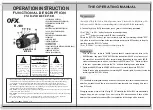
FT-2000
Operating Manual
Vertex Standard Co., Ltd.
65
verification stages on the production line.
The momentary flickering of the “TUNER” icon occurs whenever you cross over
into a new 10 kHz ATU memory window.
Note:
Although transmitter power is decreased to 100 Watts (maximum) during tuning, by
all means please check the operating frequency before beginning the tuning process, to
be sure you are not interfering with others who may already be using the frequency.
Terminology:
Antenna Tuner Memories: The microprocessor of the ATU makes a note of the positions
of the tuning capacitors and the selected inductors, and stores the data for each 10 kHz
window in which tuning has occurred. This eliminates the need to re-tune every time
you return to a frequency on which you already have completed the tuning process.
About ATU Operation
Figure 1 depicts a situation where normal tuning via the ATU has been successfully
completed, and the tuning data has been stored in the ATU memory. The antenna
system as seen by the transmitter is shown.
In Figure 2, the operator has changed frequency, and “HI SWR” icon has become
appeared. The operator presses and holds in the [TUNE] button for two seconds to
begin impedance matching using the ATU.
If a high SWR conditions exists (above 3:1), corrective action must be taken in the
antenna system to bring the impedance closer to 50 Ohms. Besides the fact that the
ATU will refuse to memorize settings on frequencies where the SWR exceeds 3:1, the
high SWR may indicate a mechanical failure in the feed system, and such failures can
lead to the generation of spurious signals causing TVI, etc.
About ATU Memories
SWR (Post-tuning) Less than 1.5:1
The tuning settings are committed to the ATU memory.
SWR (Post-tuning) Greater than 1.5:1
Tuning data will not be retained in memory. If you return to the same frequency,
the tuning process must be repeated.
SWR (Post-tuning) Greater than 3:1
















































